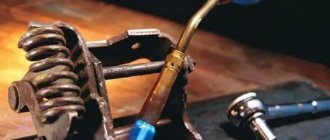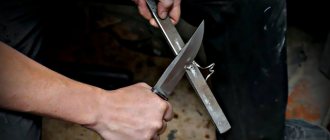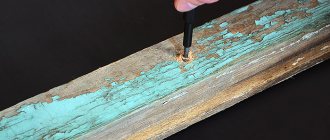Making an organizer (holder) for a socket wrench and its sockets
Once I bought a wrench in this format:
Socket heads for unscrewing/tightening nuts and a T-shaped wrench for them. 1/4″ mount (this is 6.35 mm - the size of the side of the square mount). Heads of different sizes are sold separately, strung on plastic ears... but how to store it all? To make it convenient to use.
But finding and removing the necessary heads (and even picking up the knob) is very inconvenient. Therefore, we quickly come up with, develop and manufacture a holder (stand, organizer, box) of the following final form:
I didn’t start filming a “shocking video” here about how to cut out figures from plywood with a jigsaw, drill and glue them... because all this is too primitive, no technological tricks. The main thing here is the design idea. And she is like this:
- In a strip of plywood 15 x 2 cm we drill 10 holes for 6 mm furniture dowels.
- We cut the first 6 dowels (for small heads) so that 10 mm sticks out from the top, otherwise the heads will dangle on them. We glue the dowels.
- Using a jigsaw, we cut out 4 figures of the stand for the collar and glue them to the strip with dowels.
Read more. The distance between the dowels is determined as the sum of the diameters of two adjacent heads, divided in half, plus 1.2 mm. The result is this:
For the collar, we make a stand next to it, as for a Japanese sword:
At the extreme stops, you need to grind the top down to a slope to make it easier to install the knob. The middle supports are glued at such a distance from each other and from the edges that the head of the crank can be located in the center or closer to either end. The depth of the grooves in the supports (and these grooves also widen upward for ease of throwing and installing the wrench) is such that the overhanging head of the wrench does not reach the floor (it turns out 12 mm from the floor to the handle of the wrench).
You can also make signatures on the plywood of the dimensions of the heads so that they can be seen from above:
Photo 6. Relationship between dimensions in mm and metric standards such as M2, M3, M4, M5, M6, M8
On the heads there are inscriptions of their sizes in mm - this is the distance between two opposite flat edges of the nut (see photo on the left). This is bad. Nuts, screws, and bolts are sold by the name of their metric thread, and they are also convenient to store. Although the external dimensions of the nut can be different for the same thread, there is still a basic, most common correspondence:
| M2 | M3 | M4 | M5 | M6 | M8 |
| 5 mm | 5.5 mm | 7 mm | 8 mm | 10 mm | 13 mm |
Therefore, these inscriptions M8, etc. on the resulting organizer-holder are very important: having grabbed a nut from a cell or box with the inscription M8, now we quickly grab the same socket head of the wrench, and do not strain our brains, remembering the correspondence.
PS There are two errors in Photo 6: M8 should be written at the last head, on which 13 mm is written, M3 is the second from the far end of the bit, with 5.5 mm written on it. The table above is correct.
Update 04/19/2021
A table of correspondence between nut threads (or bolt heads) and key sizes (or socket heads) in the form of one picture, which is convenient to store and view on a smartphone:
Universal screwdriver holder
Keeping a workshop clean is a very difficult task.
It is equally difficult to ensure that all the tools and materials used during work are organized and assembled. In this article we will talk about a universal holder designed for screwdrivers, which will allow you to store screwdrivers in one place, which will greatly facilitate the work and save time, which, as a rule, craftsmen spend on searching. We will need: 1. plywood 9mm thick; 2. plywood 20 mm thick; 3. drill or screwdriver; 4. Faustner drill; 5. drill. We will use the first piece of plywood, which is thinner, to make the base, and from the second piece, that is, the thick one, we will make the holder itself.
Let's start with the markup. We take a thick piece and mark the holes that we will drill for screwdrivers. There is no point in giving specific dimensions, since the holder will be different for different people, since it will be designed for different numbers of screwdrivers of different sizes. You just need to take into account that the screwdrivers must be suspended on the holder, so you also need to make grooves and cuts so that the handles of the screwdrivers do not touch each other.
We begin production by drilling grooves. These are peculiar recesses that are designed for each screwdriver separately. This can be done with a special drill, which is known as a Faustner drill.
After this, you can drill through holes for each screwdriver. After this, we make cuts that will go to the holes. This will provide additional fixation. We round the edges of the cuts, thus obtaining the shape of the necks. This is intended to make the holder easier to operate without having to spend hours aiming to hit the hole every time. We fix the finished plank to thin plywood with screws. If desired, you can apply a layer of varnish or paint on it. This completes the manufacture of the shelf - holder for screwdrivers. You can also improve it by making something like a French plank. To do this, take another plank and saw it at an angle of 45 degrees. We screw one side of the plank to the wall, and the other side directly to the shelf. This will allow you to hang the shelf with greater ease, as well as remove it from the wall with greater ease. Source
Become the author of the site, publish your own articles, descriptions of homemade products and pay for the text. Read more here.
Source
Homemade magnetic key holder
Greetings to all DIYers, in this article I will tell you how the author made a useful device in the form of a holder for key heads. Since storing tools, namely small parts, for example, heads for keys or bolts, can be difficult, so this idea was implemented. Professionals purchase tools separately and store them in a special case, but this is an extra expense. So, why not make a homemade magnetic key holder, which can be a good replacement for the most inexpensive storage option. Another plus is that each individual head will be kept in its rightful place and you won’t be afraid of losing them during transportation.
To make this useful homemade product, you need the following materials:
*Program for designing a vector image (Corel Draw). *Laser cutter. *Board thickness 130 mm, 5 x 20 cm (poplar). *Board thickness 64 mm, 5 x 40 cm (walnut). *Magnetic strip 40 cm long. *Epoxy resin. *Sandpaper. *Acrylic lacquer.
Step one. Creating a project in Corel Draw
First, you need to create a sample from which this holder blank will be laser cut. To do this, you need to have at least some basic skills in constructing vector images.
First, do the required number of circles. In the process, they will become holes into which the heads for the keys will be inserted. Make the circles with a free play allowance of + 0.05 cm so that during use you can easily insert your heads into the finished cells.
Place the circles evenly, keeping a gap of a few millimeters between them. When all the circles are ready, mark the outline of a rectangle around them, which will be the basis. The angles can be different, both regular and curly, as in our project.
Source
Types of auxiliary accessories for bits
Bits are not independent equipment. It is used in a set with special prefabricated screwdrivers, with prefabricated assembly tools and impact-type screwdrivers. Connection is carried out through a built-in adapter or through adapters - adapters. Adapters differ in the way they fix bits, and therefore they are divided into the following categories:
- magnetic bit adapters;
- with mechanical fixation.
Any type has both positive and negative properties. On sale you can find holders at a ridiculous price, which do not contain elements that allow you to fix the bits. Docking occurs by deviating the shape of the connecting hexagon of the holder from the nominal value.
Magnetic models are considered to be the most common and in demand. They are inexpensive and have a simple design. Handling them is easy and simple. The magnetic clamp brings the magnetization of the bits to such a state that they perfectly hold the fastening element on the tip. The main disadvantage is the attraction of magnetic chips and dust, which leads to clogging of the adapter hole and complicates the precise fit of the shank. To clean the magnetic clamp from all kinds of debris, you will need a lot of effort and free time, which is a serious problem.
The option of mechanical fixation is observed not only in professional models. Such aspects are important for working in any conditions, including emergency ones.
It is quite difficult for an amateur to assess the wear of a bat. Even professionals get confused. You have to independently monitor the process in which the bit slips in the area of the working profile of the fastener under heavy load conditions.
Mechanical fasteners come in the form of:
- collet type clamp;
- spring type ring.
DIY magnetic key holder for bookmarks 9
Storing tools, especially small parts like wrench sockets, bolts, etc., can sometimes be difficult. Non-professionals often purchase tools separately and storing them in a special case or box is an extra expense. However, a convenient homemade magnetic key holder can be an excellent alternative to a more expensive storage option. In addition, each head will be securely fixed in its own cell, and the entire box can be transported without fear of losing them.
- Vector image creation program (Corel Draw);
- laser cutter;
- board 130 mm thick, 5 x 20 cm (poplar);
- board 64 mm thick, 5 x 40 cm (walnut);
- magnetic strip 40 cm long;
- epoxy resin;
- sandpaper;
- acrylic lacquer.
Step 1: Create a project in Corel Draw
First of all, it is necessary to create a layout, according to which the exact blank of the holder will be cut out with a laser. To create a layout, you must have skills in constructing vector images.
First, create the number of circles you need. These will become the holes into which you will insert the sockets for the keys. Make circles the size of the diameter of the heads themselves + 0.05 cm. This is necessary so that during operation you can freely insert your heads into the prepared cells.
Distribute the circles evenly, leaving a gap of a few millimeters between them. Once you have placed all the circles, draw a rectangle around them. You can leave the corners as usual or design them figuratively, as in this project.
Socket socket holder
Authorization on the site
Hello to all DIY lovers!
In one of my previous works, I described the manufacture of a holder for open-end wrenches, see my article: “Holder for open-end wrenches.”
However, in addition to open-end wrenches, to work with threaded fasteners, it is often necessary to use socket heads. So I decided to make a wall holder for them too.
I must say that I have this set of socket heads with a key and a plastic holder.
However, the problem is that while some heads are quite difficult to remove from the holes in this holder, others, on the contrary, barely hold on and sometimes fall out, since the holes for them are already loose. And the dimensions indicated on the sides of the heads are not at all visible due to the high walls of the holder. Practice has shown that this holder is convenient to take with you if necessary, but it is not very convenient for working in the workshop.
Thinking about various options for a homemade wall holder, I first decided to settle on the most seemingly optimal option, in which the socket heads are simply inserted into holes drilled in the board.
However, since the diameters of adjacent heads do not differ very much (literally by 0.5-2 mm), it is very difficult to select drills or crowns for wood to drill holes for them.
Of course, it was possible to bore some of the holes using a round wood file, but then I came up with a better idea.
I decided to make a holder where the sockets would simply slide onto the vertical pins. Moreover, as such pins, you can use screws with plastic tubes put on them. Naturally, making such a holder is also much simpler than a holder with holes.
Rating of corner adapters and adapters
Quick from Metabo 627077000
This device belongs to the quick-release category. It has an angular shape, which allows you to work in hard-to-reach areas. It is based on the use of a quick fastening system. Can be used for both left and right rotation. The diameter of the landing square is ¼ inch. Package weight – 0.4 kg. Produced by a German concern. Assembly is carried out in Germany.
Cost – 4409 rubles.
Quick from Metabo 627077000
Advantages:
- versatility of tip profile;
- ability to work in hard-to-reach areas;
- build quality;
- time-tested manufacturer;
- increased service life.
Flaws:
- not identified.
Kwb 118410
This popular adapter is suitable for both external and internal manipulations. Product length 18.2 cm. Package weight – 0.22 kg. A brand from a time-tested German concern. Assembly is carried out on the territory of the Middle Kingdom. The diameter of the landing square is ¼ inch.
Cost – 1689 rubles.
Kwb 118410
Advantages:
- Excellent value for money and quality;
- practicality;
- increased service life;
- time-tested manufacturer.
Flaws:
- not identified.
ERGO Ryobi 5133003692
This angle-type attachment can be used in conjunction with a screwdriver. Used to work with various fasteners that are located in hard-to-reach places. An excellent solution for manipulations associated with hidden fittings and for internal furniture elements. The stated fit square is ¼ inch. Supplied in original packaging. Set weight – 0.1 kg. Brand from a famous Japanese company. Assembly is carried out on the territory of the Middle Kingdom.
Average price – 1454 rubles.
ERGO Ryobi 5133003692
Advantages:
- Japanese quality;
- practicality;
- increased service life;
- ability to work in hard-to-reach places.
Flaws:
- not identified.
IMPACT + bits (9 pcs.) Dewalt DT71517T
This set is characterized by reasonable cost and high build quality. This kit will allow you to work in any hard-to-reach areas. Makes it possible to carry out manipulations in confined spaces with narrow fasteners, including tetrahedrons. Used in assembling furniture and decorative interior elements. Product dimensions: 22x12.5x3.2 cm. Compact parameters allow you to carry the set with you. An excellent solution for intensive manipulations. Package weight 0.25 kg. The American brand is produced at production facilities located in the Middle Kingdom.
Average price – 1249 rubles.
IMPACT + bits (9 pcs.) Dewalt DT71517T
Advantages:
- versatility;
- performance;
- reliability;
- equipment;
- practicality.
Flaws:
- not identified.











